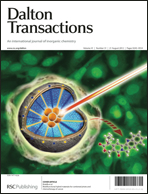The reactions of pyridinyl thioesters with triiron dodecacarbonyl: their novel diiron carbonyl complexes and mechanistic investigations†
Abstract
Reaction of Fe3(CO)12 with pyridinyl thioester ligand PyCH2SCOCH3 (L1, Py = pyridin-2-yl) produced complex, [Fe2(κ-COCH3)(μ-SCH2Py)(CO)5] (1) (PyCH2S = pyridin-2-ylmethanethiolate). When complex 1 reacted with PPh3, a monosubstituted complex, [Fe2(κ-COCH3)(μ-SCH2Py)(CO)4PPh3] (2), was derived. Reaction of the same precursor with analogous thioester ligand PyCH2SCOPy (L2) generated three novel diiron complexes, [Fe2(κ-Py)(μ-SCH2Py)(CO)5] (3), [Fe2(κ-Py)′(μ-SCH2Py)(CO)5] (4), and [Fe2(κ-Py)(μ-SCH2Py)(CO)6] (5). Complexes 3 and 4 are structural isomers. Complex 5 could be converted into complex 4 but the conversion from complex 5 to the isomer 3 was not observed. All the five complexes were fully characterised using FTIR, NMR, and other techniques. Their structures were determined using X-ray single crystal diffraction analysis. The oxidative formation of complexes 1, 3, 4, and 5 involved C–S and/or C–C bonds cleavages. To probe possible mechanisms for these cleavages, DFT calculations were performed. From the calculations, viable reaction pathways leading to the formation of all the isolated products were delineated. The results of the theoretic calculations also allowed rationalisation of the experimental observations.


 Please wait while we load your content...
Please wait while we load your content...